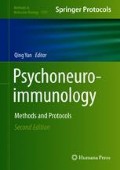Abstract
For many years, the complexity and multifactorial nature of brain-immune interactions limited our ability to dissect their underlying mechanisms. An especially challenging question was how the brain controls immunity, since the repertoire of techniques to control the brain’s activity was extremely limited. New tools, such as optogenetics and chemogenetics (e.g., DREADDs), developed over the last decade, opened new frontiers in neuroscience with major implications for neuroimmunology. These tools enable mapping the causal effects of activating/attenuating defined neurons in the brain, on the immune system. Here, we present a detailed experimental protocol for the analysis of brain-immune interactions, based on chemogenetic or optogenetic manipulation of defined neuronal populations in the brain, and the subsequent analysis of immune cells. Such detailed and systematic dissection of brain-immune interactions has the potential to revolutionize our understanding of how mental and neurological states affect health and disease.
Access this chapter
Tax calculation will be finalised at checkout
Purchases are for personal use only
References
Ben-Shaanan TL, Azulay-Debby H, Dubovik T et al (2016) Activation of the reward system boosts innate and adaptive immunity. Nat Med 22:940–944. https://doi.org/10.1038/nm.4133
Abe C, Inoue T, Inglis MA et al (2017) C1 neurons mediate a stress-induced anti-inflammatory reflex in mice. Nat Neurosci 20:700–707. https://doi.org/10.1038/nn.4526
Pavlov VA, Tracey KJ (2017) Neural regulation of immunity: molecular mechanisms and clinical translation. Nat Neurosci 20:156–166. https://doi.org/10.1038/nn.4477
Deisseroth K (2011) Optogenetics. Nat Methods 8:26–29
Roth BL (2016) DREADDs for neuroscientists. Neuron 89:683–694. https://doi.org/10.1016/j.neuron.2016.01.040
Urban DJ, Roth BL (2015) DREADDs (designer receptors exclusively activated by designer drugs): chemogenetic tools with therapeutic utility. Annu Rev Pharmacol Toxicol 55:399–417. https://doi.org/10.1146/annurev-pharmtox-010814-124803
Cardin JA, Carlén M, Meletis K et al (2010) Targeted optogenetic stimulation and recording of neurons in vivo using cell-type-specific expression of channelrhodopsin-2. Nat Protoc 5:247–254. https://doi.org/10.1038/nprot.2009.228
Furman M, Zhan Q, McCafferty C et al (2015) Optogenetic stimulation of cholinergic brainstem neurons during focal limbic seizures: effects on cortical physiology. Epilepsia 56:e198–e202. https://doi.org/10.1111/epi.13220
Zeng H, Madisen L (2012) Mouse transgenic approaches in optogenetics. Prog Brain Res 196:193–213. https://doi.org/10.1016/B978-0-444-59426-6.00010-0
Zhang F, Gradinaru V, Adamantidis AR et al (2010) Optogenetic interrogation of neural circuits: technology for probing mammalian brain structures. Nat Protoc 5:439–456. https://doi.org/10.1038/nprot.2009.226
Sidor MM, Davidson TJ, Tye KM et al (2015) In vivo optogenetic stimulation of the rodent central nervous system. J Vis Exp 95:51483. https://doi.org/10.3791/51483
Dong S, Rogan SC, Roth BL (2010) Directed molecular evolution of DREADDs: a generic approach to creating next-generation RASSLs. Nat Protoc 5:561–573. https://doi.org/10.1038/nprot.2009.239
Deisseroth K (2015) Optogenetics: 10 years of microbial opsins in neuroscience. Nat Neurosci 18:1213–1225. https://doi.org/10.1038/nn.4091
Gunaydin LA, Yizhar O, Berndt A et al (2010) Ultrafast optogenetic control. Nat Neurosci 13:387–392. https://doi.org/10.1038/nn.2495
Prigge M, Schneider F, Tsunoda SP et al (2012) Color-tuned channelrhodopsins for multiwavelength optogenetics. J Biol Chem 287:31804–31812. https://doi.org/10.1074/jbc.M112.391185
Sternson SM, Roth BL (2014) Chemogenetic tools to interrogate brain functions. Annu Rev Neurosci 37:387–407. https://doi.org/10.1146/annurev-neuro-071013-014048
Ferguson SM, Neumaier JF (2012) Grateful DREADDs: engineered receptors reveal how neural circuits regulate behavior. Neuropsychopharmacology 37:296–297. https://doi.org/10.1038/npp.2011.179
Gomez JL, Bonaventura J, Lesniak W et al (2017) Chemogenetics revealed: DREADD occupancy and activation via converted clozapine. Science 357:503–507. https://doi.org/10.1126/science.aan2475
Raper J, Morrison RD, Daniels JS et al (2017) Metabolism and distribution of clozapine-N-oxide: implications for nonhuman primate chemogenetics. ACS Chem Nerosci 8:1570–1576. https://doi.org/10.1021/acschemneuro.7b00079
Ziegenhain C, Vieth B, Parekh S et al (2017) Comparative analysis of single-cell RNA sequencing methods. Mol Cell 65:631–643.e4. https://doi.org/10.1016/j.molcel.2017.01.023
Matsumoto M, Matsuzaki F, Oshikawa K et al (2017) A large-scale targeted proteomics assay resource based on an in vitro human proteome. Nat Methods 14:251–258. https://doi.org/10.1038/nmeth.4116
Nyman TA, Lorey MB, Cypryk W, Matikainen S (2017) Mass spectrometry-based proteomic exploration of the human immune system: focus on the inflammasome, global protein secretion, and T cells. Expert Rev Proteomics 14:395–407. https://doi.org/10.1080/14789450.2017.1319768
Rieckmann JC, Geiger R, Hornburg D et al (2017) Social network architecture of human immune cells unveiled by quantitative proteomics. Nat Immunol 18:583–593. https://doi.org/10.1038/ni.3693
Cheung RK, Utz PJ (2011) Screening: CyTOF—the next generation of cell detection. Nat Rev Rheumatol 7:502–503
Spitzer MH, Nolan GP (2016) Mass cytometry: single cells, many features. Cell 165:780–791
Brodie TM, Tosevski V (2017) High-dimensional single-cell analysis with mass cytometry. Curr Protoc Immunol 118:5.11.1–5.11.25. https://doi.org/10.1002/cpim.31
Gunaydin LA, Grosenick L, Finkelstein JC et al (2014) Natural neural projection dynamics underlying social behavior. Cell 157:1535–1551. https://doi.org/10.1016/j.cell.2014.05.017
Akemann W, Mutoh H, Perron A et al (2010) Imaging brain electric signals with genetically targeted voltage-sensitive fluorescent proteins. Nat Methods 7:643–649
LeChasseur Y, Dufour S, Lavertu G et al (2011) A microprobe for parallel optical and electrical recordings from single neurons in vivo. Nat Methods 8:319–325
Acknowledgments
We would like to thank S. Schwarzbaum for editing the paper, and T.L. Ben-Shaanan, M. Schiller, and H. Azulay-Debby for their help and advice. Our research is supported by the Israeli Ministry of Science, Technology & Space (MOST; 3-12070), Prince Center for Neurodegenerative Diseases , Israeli Society for Science (1862/15), the Colleck Research Fund and the ADELIS Foundation. A.R. is a Howard Hughes Medical Institute-Wellcome Trust researcher.
Author information
Authors and Affiliations
Editor information
Editors and Affiliations
Rights and permissions
Copyright information
© 2018 Springer Science+Business Media, LLC, part of Springer Nature
About this protocol
Cite this protocol
Korin, B., Rolls, A. (2018). Application of Chemogenetics and Optogenetics to Dissect Brain-Immune Interactions. In: Yan, Q. (eds) Psychoneuroimmunology. Methods in Molecular Biology, vol 1781. Humana Press, New York, NY. https://doi.org/10.1007/978-1-4939-7828-1_11
Download citation
DOI: https://doi.org/10.1007/978-1-4939-7828-1_11
Published:
Publisher Name: Humana Press, New York, NY
Print ISBN: 978-1-4939-7827-4
Online ISBN: 978-1-4939-7828-1
eBook Packages: Springer Protocols

